
Polyvinylpyrrolidone (PVP), also commonly called polyvidone or povidone, is a water-soluble polymer made from the monomer N-vinylpyrrolidone. PVP is available in a range of molecular weights and related viscosities, and can be selected according to the desired application properties.
An antiseptic is an antimicrobial substance or compound that is applied to living tissue/skin to reduce the possibility of infection, sepsis, or putrefaction. Antiseptics are generally distinguished from antibiotics by the latter's ability to safely destroy bacteria within the body, and from disinfectants, which destroy microorganisms found on non-living objects.
Cellophane is a thin, transparent sheet made of regenerated cellulose. Its low permeability to air, oils, greases, bacteria, and liquid water makes it useful for food packaging. Cellophane is highly permeable to water vapour, but may be coated with nitrocellulose lacquer to prevent this.

K-Y Jelly is a water-based, water-soluble personal lubricant, most commonly used as a lubricant for sexual intercourse and masturbation. A variety of different products and formulas are produced under the K-Y banner, some of which are not water-soluble.
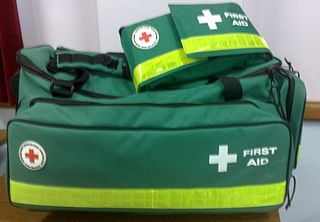
A first aid kit or medical kit is a collection of supplies and equipment used to give immediate medical treatment, primarily to treat injuries and other mild or moderate medical conditions. There is a wide variation in the contents of first aid kits based on the knowledge and experience of those putting it together, the differing first aid requirements of the area where it may be used, and variations in legislation or regulation in a given area.

An adhesive bandage, also called a sticking plaster, medical plaster, or simply plaster in British English, is a small medical dressing used for injuries not serious enough to require a full-size bandage. They are also known by the genericized trademarks of Band-Aid or Elastoplast.
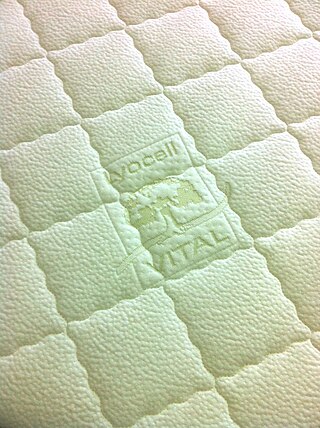
Lyocell is a semi-synthetic fiber used to make textiles for clothing and other purposes. It is a form of regenerated cellulose made by dissolving pulp and dry jet-wet spinning. Unlike rayon made by some of the more common viscose processes, Lyocell production does not use carbon disulfide, which is toxic to workers and the environment. Lyocell was originally trademarked as Tencel in 1982.

Chlorhexidine (CHX) is a disinfectant and antiseptic that is used for skin disinfection before surgery and to sterilize surgical instruments. It may be used both to disinfect the skin of the patient and the hands of the healthcare providers. It is also used for cleaning wounds, preventing dental plaque, treating yeast infections of the mouth, and to keep urinary catheters from blocking. It is used as a liquid or powder.

Povidone-iodine (PVP-I), also known as iodopovidone, is an antiseptic used for skin disinfection before and after surgery. It may be used both to disinfect the hands of healthcare providers and the skin of the person they are caring for. It may also be used for minor wounds. It may be applied to the skin as a liquid or a powder.

Merbromin is an organomercuric disodium salt compound used as a topical antiseptic for minor cuts and scrapes and as a biological dye. Readily available in most countries, it is no longer sold in Switzerland, Brazil, France, Iran, Germany, or the United States due to its mercury content.
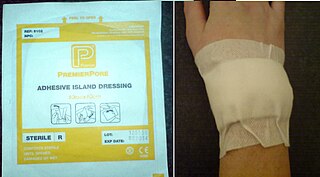
A dressing is a sterile pad or compress applied to a wound to promote healing and protect the wound from further harm. A dressing is designed to be in direct contact with the wound, as distinguished from a bandage, which is most often used to hold a dressing in place. Many modern dressings are self-adhesive.
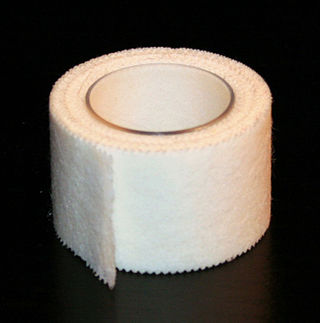
Surgical tape or medical tape is a type of pressure-sensitive adhesive tape used in medicine and first aid to hold a bandage or other dressing onto a wound. These tapes usually have a hypoallergenic adhesive which is designed to hold firmly onto skin, dressing materials, and underlying layers of tape, but to remove easily without damaging the skin. They allow air to reach the skin ("breathable"). Some breathable tapes such as kinesiology tape, and other elastic bandages with adhesive are made of cotton. Surgical tape is often white because it contains zinc oxide, which is added to help prevent infections. Tapes made of porous material, such as 3M Micropore, are widely used.
Chloroxylenol, also known as para-chloro-meta-xylenol (PCMX), is an antiseptic and disinfectant which is used for skin disinfection, and together with alcohol for cleaning surgical instruments. It is also used within a number of household disinfectants and wound cleaners. It is thought to act by disrupting microbial cell walls and inactivating cellular enzymes, and is less effective than some other available agents. It is available as a liquid.
Dakin's solution is a dilute solution of sodium hypochlorite and other stabilizing ingredients, traditionally used as an antiseptic, e.g. to cleanse wounds in order to prevent infection. The preparation was for a time called also Carrel–Dakin solution or Carrel–Dakin fluid.
Incision and drainage (I&D), also known as clinical lancing, are minor surgical procedures to release pus or pressure built up under the skin, such as from an abscess, boil, or infected paranasal sinus. It is performed by treating the area with an antiseptic, such as iodine-based solution, and then making a small incision to puncture the skin using a sterile instrument such as a sharp needle or a pointed scalpel. This allows the pus fluid to escape by draining out through the incision.
Cadexomer iodine is an iodophor that is produced by the reaction of dextrin with epichlorhydrin coupled with ion-exchange groups and iodine. It is a water-soluble modified starch polymer containing 0.9% iodine, calculated on a weight-weight basis, within a helical matrix.
A virucide is any physical or chemical agent that deactivates or destroys viruses. The substances are not only virucidal but can be also bactericidal, fungicidal, sporicidal or tuberculocidal.
Wound bed preparation (WBP) is a systematic approach to wound management by identifying and removing barriers to healing. The concept was originally developed in plastic surgery. During the year 2000, the concept was applied to systematizing the treatment of chronic wounds. The 2000 proposals recommended that wound management address the identifiable impediments to healing in order to achieve more successful outcomes. Three publications appeared that year that focused on the concept of managing the healing processes of a wound exudate, bioburden and devitalized tissue. Initially, emphasis was placed on debridement, moisture balance and bacterial balance as the three guiding principles of good wound care, while at the same time recognizing that the provision of care includes a vast array of patient, clinical and environmental variables.

Iodine is used to treat and prevent iodine deficiency and as an antiseptic. For iodine deficiency it can be given by mouth or injection into a muscle. As an antiseptic it may be used on wounds that are wet or to disinfect the skin before surgery.
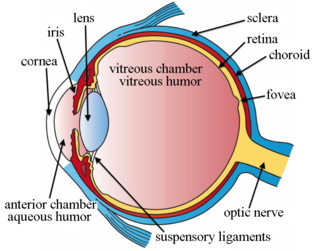
Intravitreal injection is the method of administration of drugs into the eye by injection with a fine needle. The medication will be directly applied into the vitreous humor. It is used to treat various eye diseases, such as age-related macular degeneration (AMD), diabetic retinopathy, and infections inside the eye such as endophthalmitis. As compared to topical administration, this method is beneficial for a more localized delivery of medications to the targeted site, as the needle can directly pass through the anatomical eye barrier and dynamic barrier. It could also minimize adverse drug effect to other body tissues via the systemic circulation, which could be a possible risk for intravenous injection of medications. Although there are risks of infections or other complications, with suitable precautions throughout the injection process, chances for these complications could be lowered.











